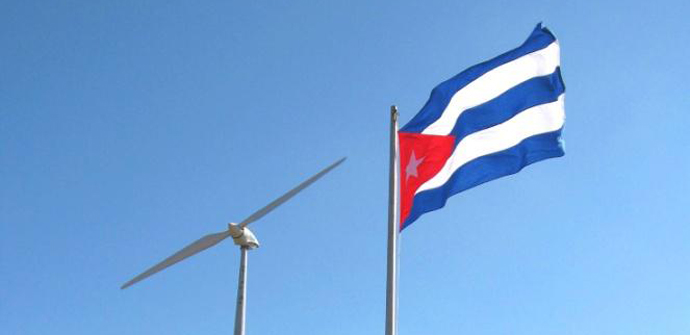
Cuba and the sources of energy
HAVANA – In the early 1980s we saw, in an area of the University of Havana, a photovoltaic panel, almost surely the first of its kind in Cuba. It was constructed by students at the School of Physics, using cells of gallium arsenide. Worldwide technology in those days could not accumulate the energy obtained from the sun, but, as a preamble with a romantic and scientific-practical slant, that Cuban effort wasn’t bad at all.

If those pioneering efforts that sought to utilize renewable energy had been kept up, the island surely would enjoy a lot more than the 4 percent of electric generation through clean systems it now has. It is hoped that that percentage will rise to 10 or 12 in a few years.
Official projects now in the works seek to install, before 2020, eight new aeolian [wind] power farms that would generate 280 megawatts. That’s an ambitious undertaking, inasmuch as at present we can only generate 11.7 MW. Later, five other farms would be created, bringing the power output to 633 MW.
The eight new farms will be set up in the center of the island, in Villa Clara and Ciego de Ávila, where two of them already exist, in Turiguanó. One is planned for Camagüey, two for Las Tunas, a province that will have the privilege of hosting the largest farm in the country, with an output of 51MW. Its 34 turbines will produce 153 GWh per year. The equivalent in fuel oil would be 40,000 tons, provided due efficiency is maintained. Holguin’s third wind farm will be installed in Banes. Holguín’s first farm has been operating in Gibara for the past five years, benefiting an average of 10,000 homes. It and the farm at Caletones Beach produce 9.6 MW.
Cuba is betting on different means to obtain clean energy. A map showing the aeolic farm distribution was designed by Cuban and Canadian organizations following a serious and detailed research process. Their map indicates the sites with the best winds in the archipelago and shows the mills that pump water for agricultural or household purposes.
The diversity needed to produce energy without petroleum is expressed by 34,658 active installations that feed from different sources. There are about 11,000 solar heaters, which could rapidly increase in number if the factory at Morón (a city in Ciego de Ávila) keeps up its output and produces them with vacuum tubes, which are better than the traditional compact tubes. But the traditional tubes would be retained.
The solar heaters serve the needs of hospitals, homes for the elderly, hotels, cattle sheds and schools. Cuba has 825 biogas facilities. By the second half of this year, the first bioelectrical facility will be created in Calimete, Matanzas, next to the Jesús Rabí Sugar Mill. It will burn sugar-cane chaff to generate 20MW, enough to provide the needs of the sugar refinery. It will also contribute 70 percent of the liquid it generates to the national electrical system.
In a second phase, this unit, which uses Chinese technology, will be able to use marabú bushes [a weed] or agricultural waste. In late 2012, a Cuban-British joint venture made a commitment to build a similar plant, one of four. The first one, to be built in Ciego de Ávila, at the Ciro Redondo Sugar Mill, should generate 30 MW by 2015.
Sun-generated electricity remains in the picture. In fact, for years, solar panels have served more than 3,600 families in rural, mountainous or isolated communities. Before the next decade, sugar-cane biomass will generate 420MW; photovoltaic cells will generate 400MW. The solar park at Cantarrana, Cienfuegos, inaugurated its initial phase this June, generating 2.6MW. In August, it will produce twice that amount, after some 600 panels are installed (for a total of 14,100) in the 5 hectares of this wholly automated park.
Some people have wondered if Cuba, being an island, couldn’t use the tides to generate energy. As it happens, however, the length of the island and its location in the tropics render the difference between the low and high tides too small to allow them to feed a generator. In an effort to sustain the achievements and facilitate the new efforts, Cuba is trying to manufacture at home the wind turbines and other equipment and components (none of which are cheap) used to create the renewable and ecological energy that it now buys from other countries. Havana is pursuing every possibility.
[Editor’s Note: The following information was obtained from Wiki Answers.]
An average U.S. household uses about 10,000 kilowatt/hours (kWh) of electricity each year. A watt is a unit of power, or energy per unit time, so it’s the rate at which energy is being used. A kilowatt-hour (or 1,000 watt/hours) is a unit of energy, so 10,000 kWh is how much total energy each household uses over the course of a year. This means that each household, on average, uses energy at a rate of about 1 kilowatt (1,000 watts can energize ten 100-watt lightbulbs). One megawatt is equal to one million watts, so for one instant, one megawatt can power 1,000 homes.
A better question to ask is how many homes can a megawatt/hour (MWh) provide with energy for one hour? If one home needs 1 kWh of energy for one hour, then 1 MWh of energy can sustain 1,000 homes for one hour.
Progreso Semanal/ Weekly authorizes the total or partial reproduction of the articles by our journalists, so long as the source and author are identified.


